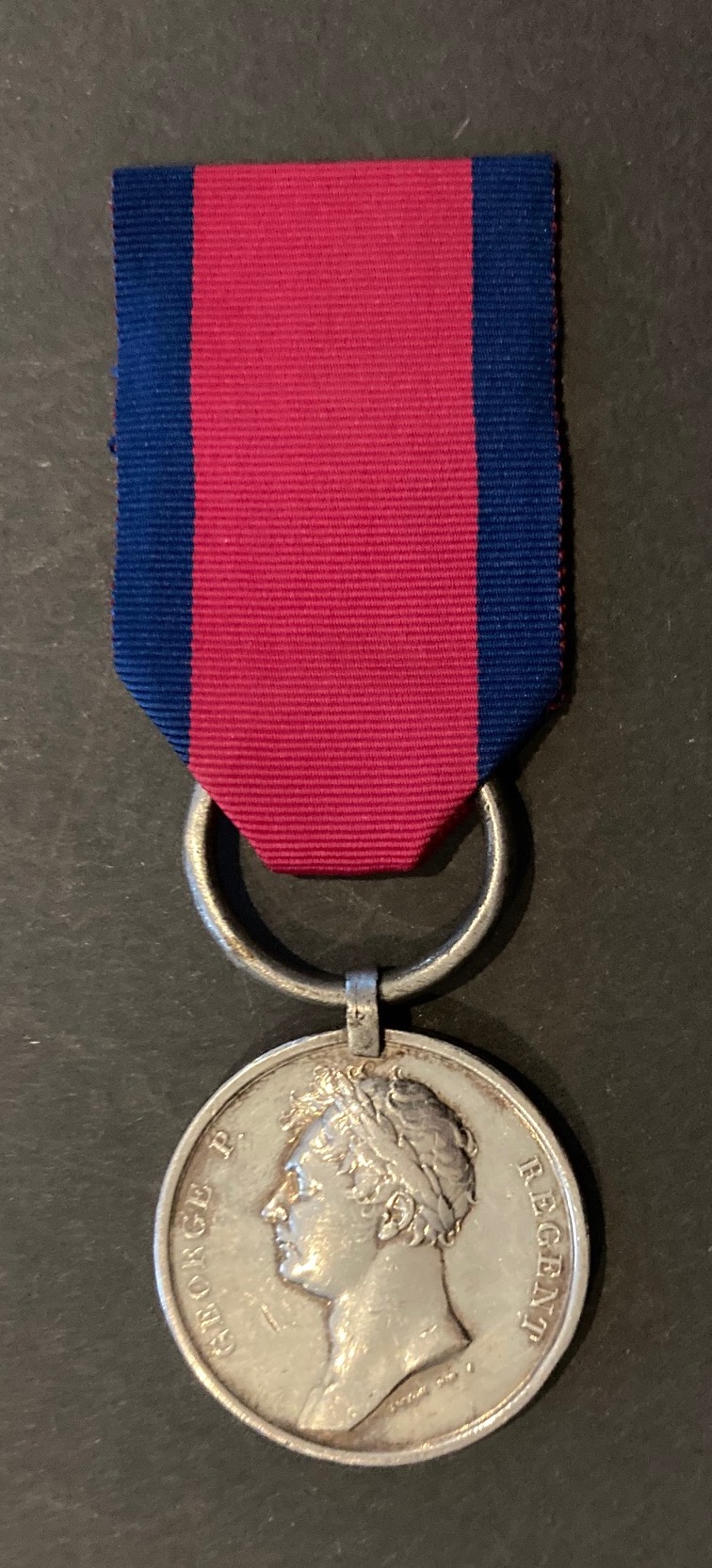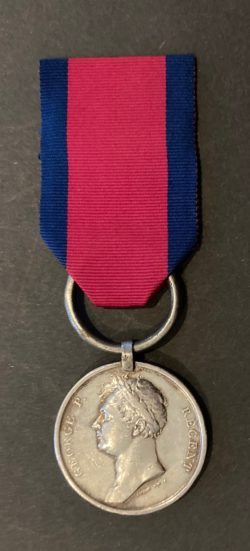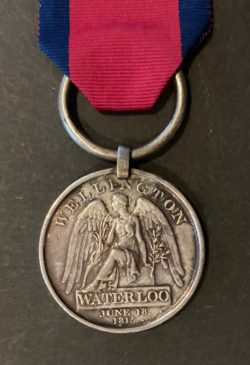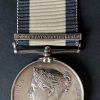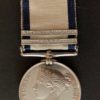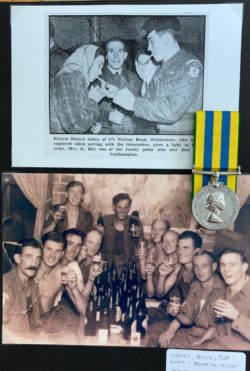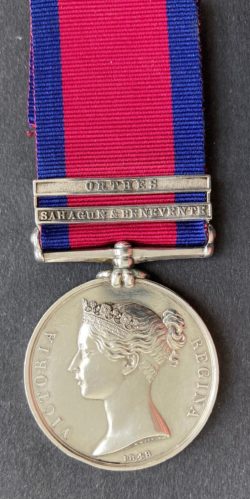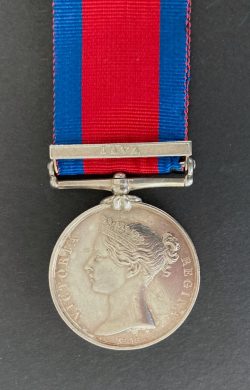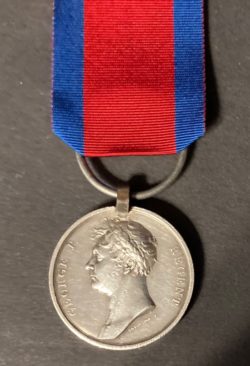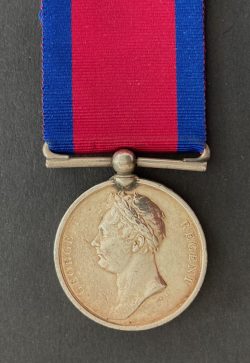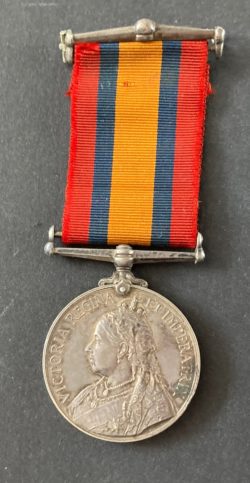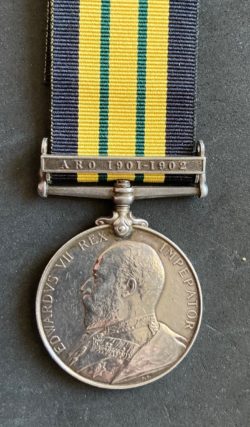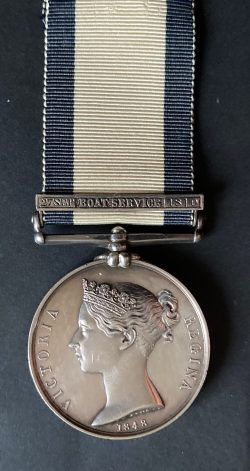Waterloo, 92nd Foot, twice severely wounded, previously Inverness Fencibles from 1794 and served in the Irish Rebellion in 1798 where he was present at the battle of Ovidstown where severely wounded , later severely wounded in the Walcheren Expedition. A rare 1798 casualty
£3,985.00
1 in stock
Waterloo
Corp. Angus M’Pherson, 1st Bat. 92nd Highlanders.
Steel clip and replacement ring suspension,
From copy discharge papers
Angus McPherson was born in the Parish of Mayhall, Inverness. He served in the Duke of York’s Royal Highlanders (retitled from Inverness Fencibles in consequence of services in Ireland 1798) from 26 December 1794 to 25 August 1802, and at the age of 25 enlisted into the 92nd Foot at Galway, Ireland, on 25 August 1806 for unlimited service. He was discharged in the rank of Corporal at Dublin on 17 November 1818, in consequence of reduction and impaired constitution. He ‘has been twice severely wounded, first while serving with the Duke of York’s Highlanders at Kilcock (Battle of Ovidstown) on 11th (sic) June 1798, and having had his leg broken on coming from Flushing while serving in the 92nd Foot on the 1st August 1809’. He served a total of 16 years 323 days and was admitted to an out-pension at the Royal Hospital, Kilmainham, on 25 November 1818.
The battle of Ovidstown was a military engagement between British Crown forces and United Irishmen rebels during the Irish Rebellion of 1798 near the town of Kilcock, County Kildare. Despite the initial failures experienced by the United Irishmen in County Kildare during the first months of the rebellion, the consolidation of government forces in the town of Naas.Towns such as Maynooth, Kilcock and Kildare had been attacked and briefly occupied by the rebels. By 19 June, however, neighbouring County Meath had been judged sufficiently pacified to allow for government forces to be dispatched from that county into Kildare to recapture rebel-held territory. under William Aylmer of Painstown,
A force, consisting of four hundred soldiers and cavalry, was sent from Trim, Co. Meath, with the aim to restore law and order to Kildare, once and for all. Colonel Irvine (2 in C Inverness Fencibles) led a detachment of Highlanders, Dragoon Guards and several troop of yeomanry. On hearing the reports of the oncoming Crown Forces, Aylmer immediately established his battle plans.
As Irvine and his troops marched close to Ovidstown, some rebel marksmen opened fire upon Irvine’s artillery and soldiers but were quickly removed from their hedge positions by Dragoons. Aylmer urgently ordered a circular formation of pikemen to charge and surround the government troops. A roaring charge by the pikemen was checked, courtesy of the artillery grapeshot and steady shots from the troops’ muskets. Attempts to seize the cannon proved fruitless and created many casualties as a result. On one occasion, a cannon shot ripped a thick hawthorn ditch to pieces, exposing dozens of pikemen, who unfortunately ran for cover whilst in the path of the Crown muskets.
As it was sometime before the Colonel could form, owing to the unevenness Of the ground, and the number of enclosures on it, the rebels kept up a smart fire and made a desperate effort to seize the cannon; but well—directed fire of the infantry made them abandon that enterprise. Soon after the troops formed, they routed the rebels, who precipitately fled to a neighboring bog, where they effected their escape, after two hundred of them had been slain.
The King ’ s troops sustained the following loss : 4th Dragoon Guards, one sergeant killed; Captain Sir Richard Steele, one sergeant, two rank and file wounded; Murgallion Cavalry, one rank
and file wounded ; Trim Cavalry, one rank and file wounded ; Duke of York’ s Highlanders, Ensign John Sutler, one sergeant, and five rank and file killed; Lieut—Colonel Irvine, one sergeant, and seven rank and file wounded, the first slightly.
Portlands Dispatch Dublin Castle, June 19, 1798. My Lord,
I have the Honour to acquaint your Grace, that………
Brigadier-General Grose,. reports from Kilcock, that Colonel Irvine, with 3 Detachment under.his Command, had this Day engaged a Body of above Two.thousand Rebels at Ovidstown Hill, about a Mile from Hortland. The Loss ofthe Rebels’ was upwards of Two Hundred slain.
The Number of killed and wounded of His Majesty’s Troops does not amount to more than Twenty-three. Ensign Sutler, of the Inverness Fencibles was killed; Colonel Irvine (commanding Inverness Fencibles) was himself wounded slightly in the Cheek; Sir Richard Steele, of the 4th Dragoon Guard?-, was also wounded, but it is hoped not dangerously. Colonel Irwine reports to General Grose, that he is. highly indebted to all the Officers and Men who served under him,.
The Accounts received from te North are favourable, and state that the Rebels are dispersed in all quarters.
Quatres Bras & Waterloo
The 92nd were attached to Pack’s Brigade, part of Picton’s 5th Division. Hector served under Captain William McKay. The Battle of Quatre Bras was a bloodbath for the 92nd who lost 286 men including their Commanding Officer Lt Col Cameron who had led his men through the Peninsular War. On the 18th June at the Battle of Waterloo the 92nd joined the famous charge of the Royal Scots Greys, where many of the men grabbed the stirrups of the cavalry men to carry them into battle.
The 92nd had a leading role in the Battle of Quatre Bras on 16 June, where it was one of the regiments defending the disputed crossroads and later halted a French attack with a bayonet charge. Two days later. the regiment were in action again at the Battle of Waterloo, although by now reduced to only about 250 men. At an early stage, Napoleon’s troops attacked the left of the Allied line, and the 92nd were ordered to charge the leading French column. Upon the approach of the Highlanders, the head of the French column broke in disorder and could only be caught by the horses of the Scots Greys, who passed through the 92nd to get at them. According to some accounts, some of the Highlanders clung to the stirrups of the passing Greys so that they could reach the French, although this is often dismissed as mere legend. However, the testimony of Corporal Dickson of “F” Troop of the Scots Greys, says; “They were all Gordons, and as we passed through them they shouted ‘Go at them the Greys! Scotland for ever!’ My blood thrilled at this and I clutched my sabre tighter. Many of them grasped our stirrups and in the fiercest excitement, dashed with us into the fight.”
A fine 92nd man and a particularly rare 1798 casualty

